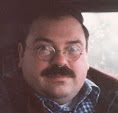The plate is 1/16" x 3" x 4" cut from an old letterpress half-tone plate. The former front of that plate is now the back, of course. I'll be buying proper plates in the future but a friend of mine generously gave me some of these that his father had kept for years as scrap metal. They were long since useless for their intended purpose but work great for practice here. They do have some issues and I cleaned and flattened what is now the face but without going to Herculean efforts. For the moment they're more than satisfactory.
I brushed shellac on the back since I wanted to save money and not buy asphaltum or use the hard ground that is used on the front of the plate for this purpose and because I had plenty of shellac. I then brushed hard ground on the face and let it dry overnight.
I drew the image on paper with a No. 2 pencil and I laid this upside down on the plate, wrapped it around the back and taped it. I then put it through the Kelton press and removed the paper. Even though the ground was quite dark the graphite adhered and the image showed up very clear and sharp. Using a medium-sized needle I made, I needled the image on the plate.
I laid the plate face down at an angle in a glass baking dish. I was using ferric chloride instead of acid so while I didn't need a feather to brush away the bubbles I had to allow for the dissolving copper to drop off the plate and not hinder the etching process by filling the etched lines. I had read different things about how much time to allow for the etching. After 15 minutes I pulled the plate out and checked it but couldn't really tell what was happening. I placed it back in the dish and found the old enlarger lens that I often use for a loop. I pulled it out again and then could see that it was working. I put it back in and after a total of about a half hour took it out and rinsed it off in water. I was surprised how nice, at least to my eyes, it looked.
I couldn't wait to print a couple proofs with it and the results are below.The first proof was on the unknown, approx. 20 lb. cotton laid paper I've been using up until now since I have a bunch of it I got for free. Note the dark vertical lines where the ferric chloride bit slightly through the hard ground. Next time I will have to pay more careful attention. The brushing left light and dark streaks, thicker and thinner, even though the coverage was complete.
For this next I wiped the plate cleaner and the vertical lines did not show up as much. Unfortunately I've found that scanning these prints instead of photographing them shows unsightly things that are not visible when looking at them directly. Not to mention that my scanner leaves strange horizontal lines in the image. But until I can get a decent camera this will have to do.
This last was with another more cleanly wiped plate but this time I used a heavier paper, 150 lb cotton rag. This is Graphic Chemical's "house paper" and aside from the fact that it is pretty inexpensive, seems to do a pretty nice job. Of course, I have little experience with which to really evaluate it against other papers. I didn't allow it to soak long enough and it did not press into the plate as well as it should have. Next time I'll remember...that and many other things I didn't take into account. Like the blobs of ink I missed on the edge of the plate on the last proof!
I'm teaching myself how to do all this and so far I'm rather pleased with the result.






+With+Press+cropped.jpg)



No comments:
Post a Comment